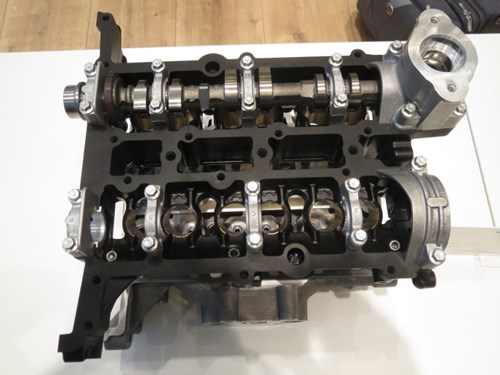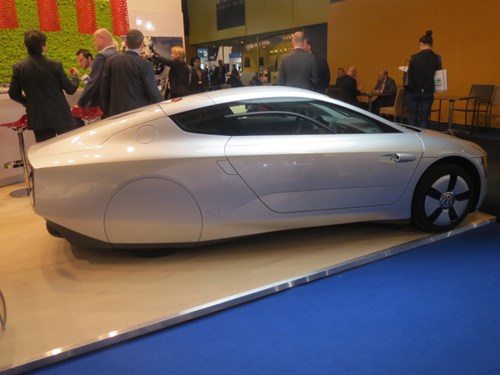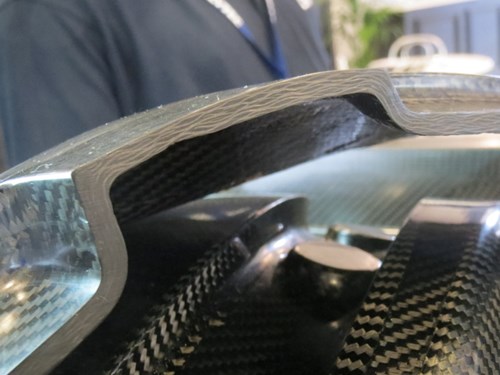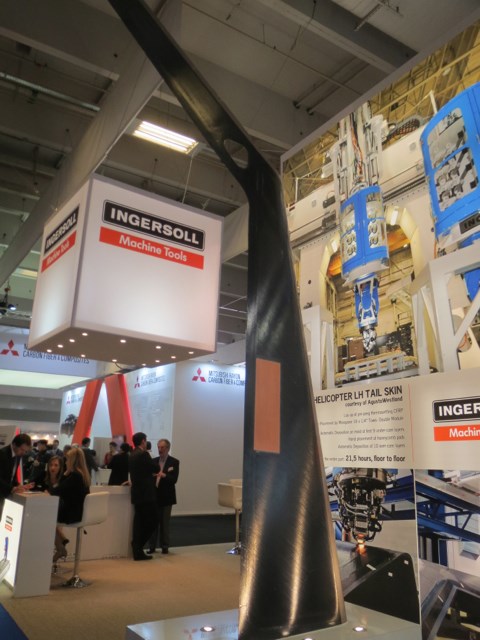Known knowns, known unknowns, unknown unknowns
JEC Europe 2015, March 10-12 in Paris, shed some light on where composites are, and where they're headed.
Share

Hexion featured at JEC Europe this Bakelite thermoset cam carrier reinforced with carbon fiber, developed with Ford Motor Co. and WGS Global Services.
The composites industry’s largest trade show, JEC Europe, was held last week (March 10-12) in Paris. It was, as usual, big and busy and full of interesting technologies, products, innovations, rumors, heresay and speculation. CW was there, as usual, to cover the event. You can find our initial report on the show in the News section of the CW site, and in the May 2015 issue of CompositesWorld. In the meantime:
Known knowns: As dynamic as the composites industry is, there are some givens at a show like JEC that seem difficult for exhibitors to avoid. For instance, there was the usual assortment of high-end sports, production and racing cars, designed to attract attention and demonstrate exhibitor capability of some sort. There was also a healthy collection of aerospace parts of all types — structural and interior. Indeed, aerospace and automotive were the two end markets most referenced at the show, which makes sense given the prominence they hold for composites fabricators.

Mubea Carbo Tech featured the Volkswagen XL1, which has a resin transfer molded monocoque.
The big question on many lips was this: Will composites take of in automotive, and when? The consistent answer was: Yes and 2020-2025. The thinking seems to be that automakers and their Tier 1 suppliers are in the midst of sorting out resin, fiber, processing and application options, with an eye toward implementation in the early part of the next decade. This makes sense given some of the big questions that must be answered by automakers, and none is bigger than that of carbon fiber supply. If an automaker decides to apply carbon fiber to a vehicle on the same scale as BMW has with the i3, fiber supply must be guaranteed. Establishing that guarantee is no small task and might require an automaker to establish partnership of the type BMW created with SGL Group. Meanwhile, many resin and machinery suppliers appear to be developing and proving new fast-curing/short-cycle technologies that they hope will soon find a home in a high-volume automotive manufacturing environment. So, mark your calendar for 2020-2025, but you’d better use a pencil.

Cytec introduced new BMI and epoxy versions of its DForm tooling prepreg, offered in 24-inch by 24-inch multiply tiles for faster, more efficient layup.
Known unknowns: After a nice decade-plus long run developing materials and equipment for four very large aerospace programs (Airbus A380, Boeing 787, Airbus A350 XWB, Boeing 777X), major suppliers to the all-important aerospace industry appear to be asking the same question: Now what? These aircraft programs consumed much attention and resources for a very long time — so long, in fact, that the largesse had become the status quo. However, with the A350 XWB now in service, the supply chains for these programs have been indefinitely fixed. Even the re-winging of the 777X, which will feature carbon fiber composites, has seen its supply chain established and locked down. And while there are a few aero programs on the margins that offer nice work packages (i.e., Sikorsky CH-53K, Bombardier CSeries, Irkut MS-21, etc.), there is no major aero program on the horizon. Beyond the horizon, lurking, are the redesign of the Airbus A320 and Boeing 737, but the year most frequently associated with such programs is 2030. And even if they do come to pass, where and how composites might be used on these single-aisle aircraft is an open question.

Ingersoll Machine Tools' Mongoose fiber placement machine was used to layup this AgustaWestland helicopter tailskin in a honeycomb core construction.
Unknown unknowns: One under-appreciated feature of the composites industry is it’s highly dynamic nature. As someone who came from outside the industry, I understand well that the mix of resin, fiber, tooling and manufacturing processes employed by composites fabricators almost guarantees rapid innovation and fast change. This means that there are composites applications still in their infancy, or yet to come to life, that could one day become dominant — or more dominant. Offshore wind blades, pressure vessels, and oil and gas structures spring to mind.
If JEC is a snapshot of the health of the composites industry, it must be pronounced robust and growing, perhaps in adolescence and still trying to figure out who and what it is. But with a promising future ahead.
Related Content
PEEK vs. PEKK vs. PAEK and continuous compression molding
Suppliers of thermoplastics and carbon fiber chime in regarding PEEK vs. PEKK, and now PAEK, as well as in-situ consolidation — the supply chain for thermoplastic tape composites continues to evolve.
Read MoreNext-generation airship design enabled by modern composites
LTA Research’s proof-of-concept Pathfinder 1 modernizes a fully rigid airship design with a largely carbon fiber composite frame. R&D has already begun on higher volume, more automated manufacturing for the future.
Read MoreCombining multifunctional thermoplastic composites, additive manufacturing for next-gen airframe structures
The DOMMINIO project combines AFP with 3D printed gyroid cores, embedded SHM sensors and smart materials for induction-driven disassembly of parts at end of life.
Read MorePlant tour: Spirit AeroSystems, Belfast, Northern Ireland, U.K.
Purpose-built facility employs resin transfer infusion (RTI) and assembly technology to manufacture today’s composite A220 wings, and prepares for future new programs and production ramp-ups.
Read MoreRead Next
All-recycled, needle-punched nonwoven CFRP slashes carbon footprint of Formula 2 seat
Dallara and Tenowo collaborate to produce a race-ready Formula 2 seat using recycled carbon fiber, reducing CO2 emissions by 97.5% compared to virgin materials.
Read MorePlant tour: Daher Shap’in TechCenter and composites production plant, Saint-Aignan-de-Grandlieu, France
Co-located R&D and production advance OOA thermosets, thermoplastics, welding, recycling and digital technologies for faster processing and certification of lighter, more sustainable composites.
Read MoreDeveloping bonded composite repair for ships, offshore units
Bureau Veritas and industry partners issue guidelines and pave the way for certification via StrengthBond Offshore project.
Read More






















